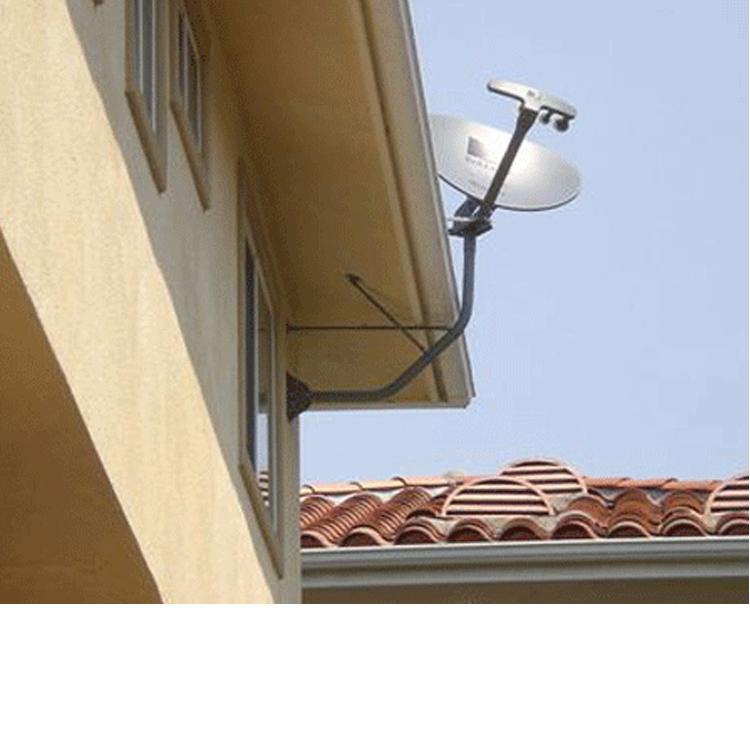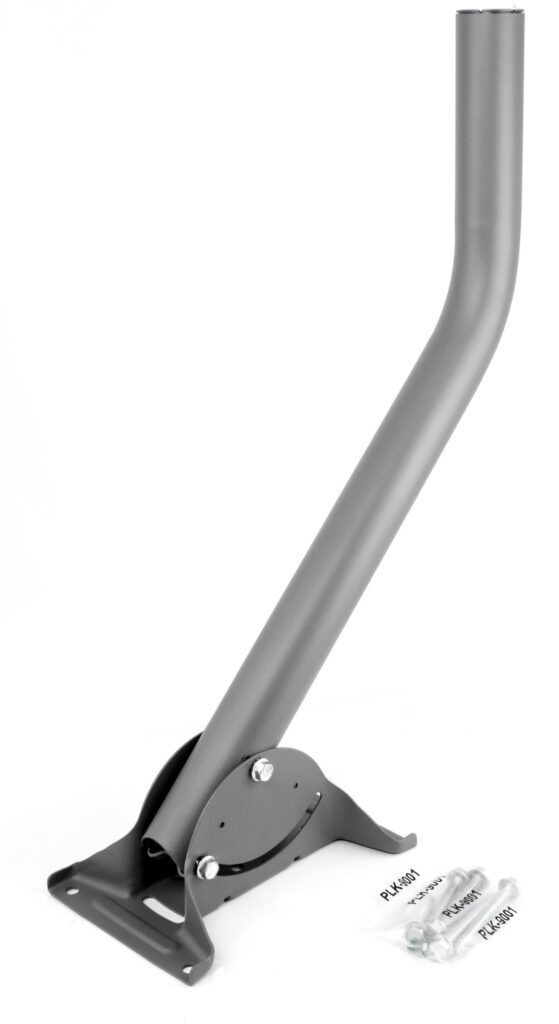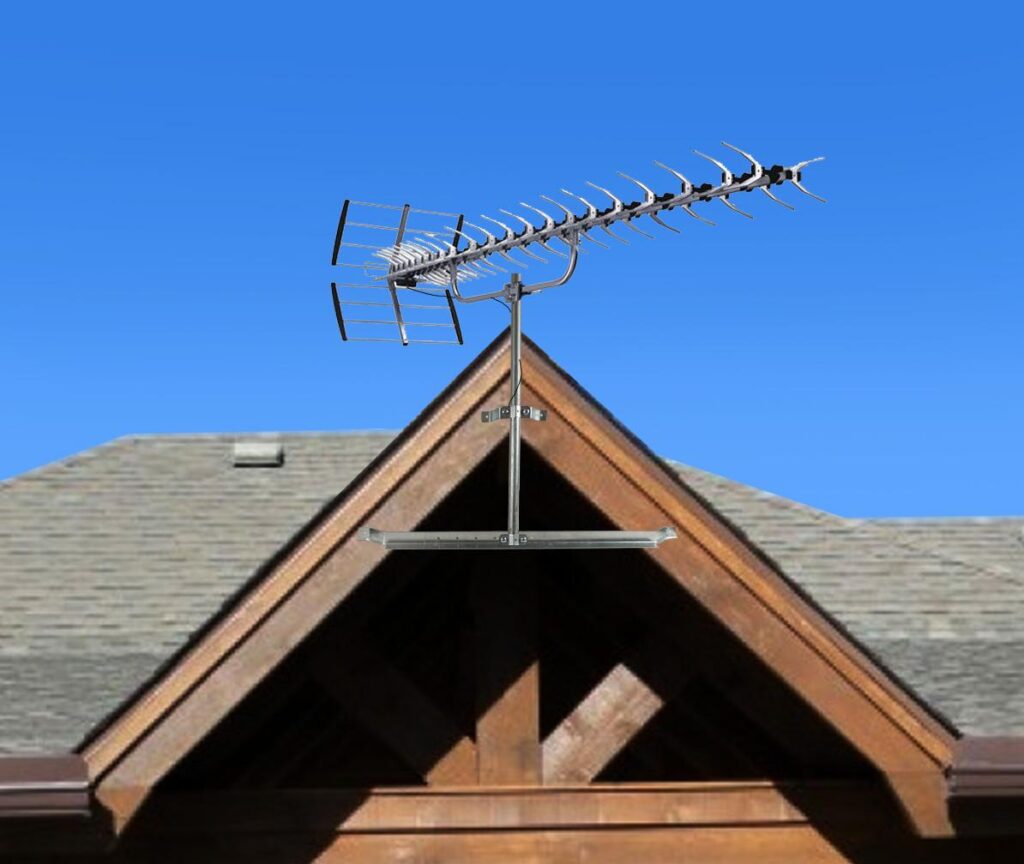Eave mounts are a very popular way to put an antenna or satellite dish on your home. But, hardly a day goes by when someone doesn’t ask if this antenna or that antenna will work with an eave mount. The answer is always “maybe,” and that means it’s a great time to write an article for The Solid Signal Blog.
People have heard of “eavesdropping” but they may not know what an “eave” is. An eave is that little space that your roof covers that goes beyond the walls of your house. It’s usually capped at the end by something called a fascia board, which is that long piece of wood at the very end of the eave.
Side note: they call it “eavesdropping” because it originally meant standing so close to the house that you could hear what was being said inside.
There are a lot of different ways to mount something to an eave. The sturdiest method of mounting something is this under-eave mount:

In this scenario, the antenna or satellite dish is mounted under the eave, but it’s mounted to the wall of the house. If there are braces or any other thing to stabilize it, that’s mounted to the eave. This is the best mount and it should be able to hold virtually any antenna you want to use.
If you want to mount to a fascia board, you can also choose a mount like this one:

Mounts of this sort are called J-mounts because the pole part of it (the mast) resembles a letter J a little bit. With something like this, you can mount directly to the fascia board. However, the mount won’t be able to bear a lot of weight if there is any rot in your fascia board. The screws will just tear out. You can also attach this J-mount to the rafters under the eave if it allows you to still put the antenna where you want. That’s going to depend on the slope of your rafters.
If you don’t want to make holes in the house but you want a little more strength than the typical J-mount can provide, you can choose a mount like this:

This is referred to as a gable mount because that pointy part of the roof is called a gable. (See the things you’ll learn on this blog?) It mounts to the fascia board in three places to distribute weight more evenly. A mount like this one should be able to take practically anything you put on it, provided that your fascia boards are in good shape.
Typically, if your home is in good shape, you can put 15-20 pounds of weight onto any of these mounts without a problem. But there are just so many variables. If you’re mounting to a wall, are you mounting into a stud, or just relying on the plywood under your siding or stucco? Is there any sign of rot or any other age-related issue? How strong are the winds typically in your area? Do you think it’s possible that whatever you’re mounting could get buried under five pounds of wet snow? There are just so many questions and it’s really not possible to come up with a formula to account for all of them.
Try to brace things as well as possible. Mount to something that’s as sturdy as possible. Check the mount point to make sure it’s nice and strong. It’s rare to have an antenna that weighs more than about 10 pounds so you’ll usually be ok. But, some of the larger ones can be heavy. If you’re going to be in an area where wind or weather is a factor, don’t choose a fascia mount. Instead, choose a chimney mount. A chimney mount is two metal bands that wrap around a brick chimney. As long as those bricks are solid, you can put virtually anything into a chimney mount without any problem.
If you have more questions, call us! We’re here for you during East Coast business hours. The number is 888-233-7563. If it’s after hours, fill out the form below. We’ll get right back to you!
The post What’s the heaviest antenna you can mount to your eave? appeared first on The Solid Signal Blog.
Continue reading...
First off, what’s an eave?
People have heard of “eavesdropping” but they may not know what an “eave” is. An eave is that little space that your roof covers that goes beyond the walls of your house. It’s usually capped at the end by something called a fascia board, which is that long piece of wood at the very end of the eave.
Side note: they call it “eavesdropping” because it originally meant standing so close to the house that you could hear what was being said inside.
Mounting to your eave or fascia board
There are a lot of different ways to mount something to an eave. The sturdiest method of mounting something is this under-eave mount:

In this scenario, the antenna or satellite dish is mounted under the eave, but it’s mounted to the wall of the house. If there are braces or any other thing to stabilize it, that’s mounted to the eave. This is the best mount and it should be able to hold virtually any antenna you want to use.
If you want to mount to a fascia board, you can also choose a mount like this one:

Mounts of this sort are called J-mounts because the pole part of it (the mast) resembles a letter J a little bit. With something like this, you can mount directly to the fascia board. However, the mount won’t be able to bear a lot of weight if there is any rot in your fascia board. The screws will just tear out. You can also attach this J-mount to the rafters under the eave if it allows you to still put the antenna where you want. That’s going to depend on the slope of your rafters.
If you don’t want to make holes in the house but you want a little more strength than the typical J-mount can provide, you can choose a mount like this:

This is referred to as a gable mount because that pointy part of the roof is called a gable. (See the things you’ll learn on this blog?) It mounts to the fascia board in three places to distribute weight more evenly. A mount like this one should be able to take practically anything you put on it, provided that your fascia boards are in good shape.
So why can’t we just tell you how much weight it’s going to take?
Typically, if your home is in good shape, you can put 15-20 pounds of weight onto any of these mounts without a problem. But there are just so many variables. If you’re mounting to a wall, are you mounting into a stud, or just relying on the plywood under your siding or stucco? Is there any sign of rot or any other age-related issue? How strong are the winds typically in your area? Do you think it’s possible that whatever you’re mounting could get buried under five pounds of wet snow? There are just so many questions and it’s really not possible to come up with a formula to account for all of them.
As a general rule…
Try to brace things as well as possible. Mount to something that’s as sturdy as possible. Check the mount point to make sure it’s nice and strong. It’s rare to have an antenna that weighs more than about 10 pounds so you’ll usually be ok. But, some of the larger ones can be heavy. If you’re going to be in an area where wind or weather is a factor, don’t choose a fascia mount. Instead, choose a chimney mount. A chimney mount is two metal bands that wrap around a brick chimney. As long as those bricks are solid, you can put virtually anything into a chimney mount without any problem.
If you have more questions, call us! We’re here for you during East Coast business hours. The number is 888-233-7563. If it’s after hours, fill out the form below. We’ll get right back to you!
The post What’s the heaviest antenna you can mount to your eave? appeared first on The Solid Signal Blog.
Continue reading...

